Moran M.J., Shapiro H.N. Fundamentals of Engineering Thermodynamics
Подождите немного. Документ загружается.


9.124 An ideal gas mixture with k 5 1.31 and a molecular
weight of 23 is supplied to a converging nozzle at p
o
5 5 bar,
T
o
5 700 K, which discharges into a region where the
pressure is 1 bar. The exit area is 30 cm
2
. For steady isentropic
flow through the nozzle, determine
(a) the exit temperature of the gas, in K.
(b) the exit velocity of the gas, in m/s.
(c) the mass flow rate, in kg/s.
9.125 An ideal gas expands isentropically through a converging
nozzle from a large tank at 120 lbf/in.
2
, 6008R, and discharges
into a region at 60 lbf/in.
2
Determine the mass flow rate, in
lb/s, for an exit flow area of 1 in.
2
, if the gas is
(a) air, with k 5 1.4.
(b) carbon dioxide, with k 5 1.26.
(c) argon, with k 5 1.667.
9.126 Air at p
o
5 1.4 bar, T
o
5 280 K expands isentropically
through a converging nozzle and discharges to the atmosphere
at 1 bar. The exit plane area is 0.0013 m
2
.
(a) Determine the mass flow rate, in kg/s.
(b) If the supply region pressure, p
o
, were increased to 2 bar,
what would be the mass flow rate, in kg/s?
9.127 Air enters a nozzle operating at steady state at 45 lbf/in.
2
,
8008R, with a velocity of 480 ft/s, and expands isentropically
to an exit velocity of 1500 ft/s. Determine
(a) the exit pressure, in lbf/in.
2
(b) the ratio of the exit area to the inlet area.
(c) whether the nozzle is diverging only, converging only, or
converging–diverging in cross section.
9.128 Air as an ideal gas with k
5 1.4 enters a converging–
diverging nozzle operating at steady state and expands
isentropically as shown in Fig. P9.128. Using data from the
figure and from Table 9.2 as needed, determine
(a) the stagnation pressure, in lbf/in.
2
, and the stagnation
temperature, in 8R.
(b) the throat area, in in.
2
(c) the exit area, in in.
2
the nozzle is choked, and the diverging portion acts as a
supersonic nozzle, determine the mass flow rate, in kg/s, and
the Mach number, pressure, in bar, and temperature, in K, at
the exit. Repeat if the diverging portion acts as a supersonic
diffuser.
9.131 A converging–diverging nozzle operates at steady state.
Air as an ideal gas with k
5 1.4 enters the nozzle at 500 K,
6 bar, and a Mach number of 0.3. The air flows isentropically
to the exit plane, where a normal shock stands. The
temperature just upstream of the shock is 380.416 K.
Determine the back pressure, in bar.
9.132 A converging–diverging nozzle operates at steady state.
Air as an ideal gas with k
5 1.4 enters the nozzle at 500 K,
6 bar, and a Mach number of 0.3. A normal shock stands in
the diverging section at a location where the Mach number
1.40. The cross-sectional areas of the throat and the exit
plane are 4 cm
2
and 6 cm
2
, respectively. The flow is isentropic,
except where the shock stands. Determine the exit pressure,
in bar, and the mass flow rate, in kg/s.
9.133 Air as an ideal gas with k
5 1.4 enters a converging-
diverging duct with a Mach number of 2. At the inlet, the
pressure is 26 lbf/in.
2
and the temperature is 4458R. A normal
shock stands at a location in the converging section of the
duct, with M
x
5 1.5. At the exit of the duct, the pressure is
150 lbf/in.
2
The flow is isentropic everywhere except in the
immediate vicinity of the shock. Determine temperature, in
8R, and the Mach number at the exit.
9.134 Air as an ideal gas with k 5 1.4 undergoes a normal
shock. The upstream conditions are p
x
5 0.5 bar, T
x
5 280 K,
and M
x
5 1.8. Determine
(a) the pressure p
y
, in bar.
(b) the stagnation pressure p
ox
, in bar.
(c) the stagnation temperature T
ox
, in K.
(d) the change in specific entropy across the shock, in
kJ/kg ? K.
(e) Plot the quantities of parts (a)–(d) versus M
x
ranging from
1.0 to 2.0. All other upstream conditions remain the same.
9.135 A converging–diverging nozzle operates at steady state.
Air as an ideal gas with k
5 1.4 flows through the nozzle,
discharging to the atmosphere at 14.7 lbf/in.
2
and 5208R. A
normal shock stands at the exit plane with M
x
5 1.5. The
exit plane area is 1.8 in.
2
Upstream of the shock, the flow is
isentropic. Determine
(a) the stagnation pressure p
ox
, in lbf/in.
2
(b) the stagnation temperature T
ox
, in 8R.
(c) the mass flow rate, in lb/s.
9.136 A converging–diverging nozzle operates at steady state.
Air as an ideal gas with k
5 1.4 flows through the nozzle,
discharging to the atmosphere at 14.7 lbf/in.
2
and 5108R. A
normal shock stands at the exit plane with p
x
5 9.714 lbf/in.
2
The exit plane area is 2 in.
2
Upstream of the shock, the flow
is isentropic. Determine
(a) the throat area, in in.
2
(b) the entropy produced in the nozzle, in Btu/8R per lb of
air flowing.
Problems: Developing Engineering Skills 583
Fig. P9.128
M
1
= 0.2
T
1
= 595°R
p
1
= 77.8 lbf/in.
2
m
·
= 1 lb/s
M
2
= 1.5
1
2
Throat
9.129 Air as an ideal gas with k 5 1.4 enters a diffuser operating
at steady state at 4 bar, 290 K, with a velocity of 512 m/s.
Assuming isentropic flow, plot the velocity, in m/s, the Mach
number, and the area ratio A/A* for locations in the flow
corresponding to pressures ranging from 4 to 14 bar.
9.130 A converging–diverging nozzle operating at steady state
has a throat area of 3 cm
2
and an exit area of 6 cm
2
. Air as an
ideal gas with k 5 1.4 enters the nozzle at 8 bar, 400 K, and a
Mach number of 0.2, and flows isentropically throughout. If
c09GasPowerSystems.indd Page 583 7/19/10 10:28:31 AM users-133 c09GasPowerSystems.indd Page 583 7/19/10 10:28:31 AM users-133 /Users/users-133/Desktop/Ramakant_04.05.09/WB00113_R1:JWCL170/New/Users/users-133/Desktop/Ramakant_04.05.09/WB00113_R1:JWCL170/New
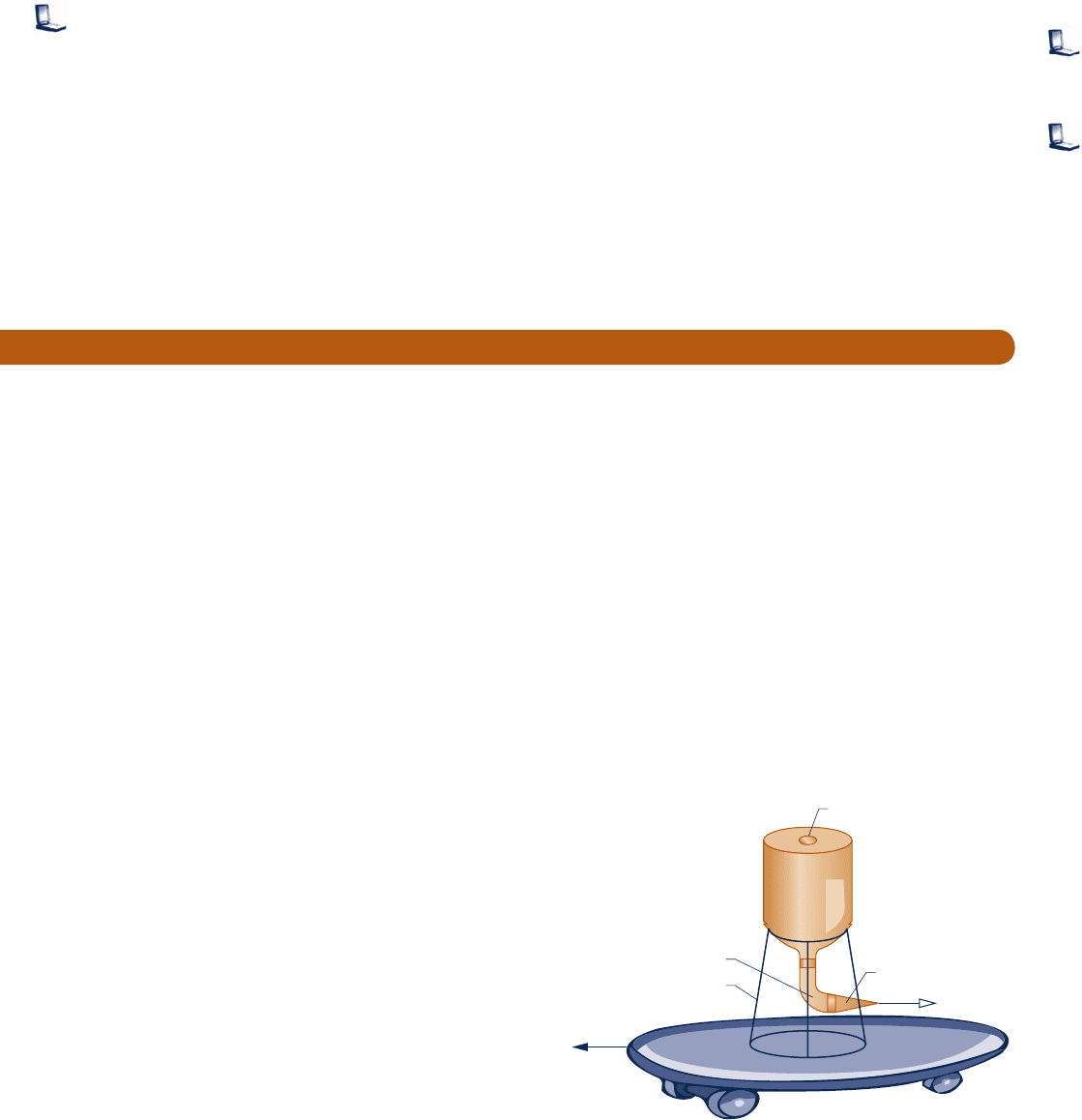
584 Chapter 9 Gas Power Systems
9.137 Air at 3.4 bar, 530 K, and a Mach number of 0.4 enters
a converging–diverging nozzle operating at steady state. A
normal shock stands in the diverging section at a location
where the Mach number is M
x
5 1.8. The flow is isentropic,
except where the shock stands. If the air behaves as an ideal
gas with k
5 1.4, determine
(a) the stagnation temperature T
ox
, in K.
(b) the stagnation pressure p
ox
, in bar.
(c) the pressure p
x
, in bar.
(d) the pressure p
y
, in bar.
(e) the stagnation pressure p
oy
, in bar.
(f) the stagnation temperature T
oy
, in K.
If the throat area is 7.6 3 10
24
m
2
, and the exit plane pressure
is 2.4 bar, determine the mass flow rate, in kg/s, and the exit
area, in m
2
.
9.138 Air as an ideal gas with k
5 1.4 enters a converging–
diverging channel at a Mach number of 1.6. A normal shock
stands at the inlet to the channel. Downstream of the shock
the flow is isentropic; the Mach number is unity at the throat;
and the air exits at 20 lbf/in.
2
, 7008R, with negligible velocity.
If the mass flow rate is 45 lb/s, determine the inlet and throat
areas, in ft
2
.
9.139 Derive the following expressions: (a) Eq. 9.55, (b) Eq.
9.56, (c) Eq. 9.57.
9.140 Using Interactive Thermodynamics: IT, generate tables
of the same isentropic flow functions as in Table 9.2 for
specific heat ratios of 1.2, 1.3, 1.4, and 1.67 and Mach numbers
ranging from 0 to 5.
9.141 Using Interactive Thermodynamics: IT, generate tables
of the same normal shock functions as in Table 9.3 for
specific heat ratios of 1.2, 1.3, 1.4, and 1.67 and Mach numbers
ranging from 1 to 5.
c DESIGN & OPEN-ENDED PROBLEMS: EXPLORING ENGINEERING PRACTICE
9.1D Congress has mandated the average fuel economy for
passenger cars sold in the United States to be 35 miles per
gallon beginning in 2020. In Europe, the goal is 47 miles per
gallon by 2012. In each case, identify the major factors
spurring legislative action, including, as appropriate, technical,
economic, societal, and political factors. Analyze the disparity
between these goals. Comment on their likely effectiveness
in achieving the respective legislative aims. Report your
findings in a PowerPoint presentation.
9.2D Automotive gas turbines have been under development
for decades but have not been commonly used in automobiles.
Yet helicopters routinely use gas turbines. Explore why
different types of engines are used in these respective
applications. Compare selection factors such as performance,
power-to-weight ratio, space requirements, fuel availability,
and environmental impact. Summarize your findings in a
report with at least three references.
9.3D The Annual Energy Outlook with Projections
report
released by the U.S. Energy Information Administration
projects annual consumption estimates for various fuel types
through the next 25 years. According to the report, biofuels
will play an increasing role in the liquid fuel supply over that
time period. Based on technologies commercially available
or reasonably expected to become available in the next
decade, identify the most viable options for producing
biofuels. Compare several options based on energy return on
energy invested (EROEI), water and land requirements, and
effects on global climate change. Draw conclusions based on
your study, and present your findings in a report with at least
three references.
9.4D Investigate the following technologies: plug-in hybrid
vehicles, all-electric vehicles, hydrogen fuel cell vehicles,
diesel-powered vehicles, natural gas–fueled vehicles, and
ethanol-fueled vehicles, and make recommendations on
which of these technologies should receive federal research,
development, and deployment support over the next decade.
Base your recommendation on the result of a decision matrix
method such as the Pugh method to compare the various
technologies. Clearly identify and justify the criteria used for
the comparison and the logic behind the scoring process.
Prepare a 15-minute briefing and an executive summary
suitable for a conference with your local congressperson.
9.5D Figure P9.5D shows a wheeled platform propelled by
thrust generated using an onboard water tank discharging
water through an elbow to which a nozzle is attached. Design
and construct such an apparatus using easily obtained materials
like a skateboard and one-gallon milk jug. Investigate the
effects of elbow angle and nozzle exit area on volumetric flow
and thrust. Prepare a report including results and conclusions
together with an explanation of the measurement techniques
and experimental procedures.
Fig. P9.5D
Nozzle
Water tank stand
Elbow (tubing)
Opening for atmosphere exposure
c09GasPowerSystems.indd Page 584 7/19/10 10:28:34 AM users-133 c09GasPowerSystems.indd Page 584 7/19/10 10:28:34 AM users-133 /Users/users-133/Desktop/Ramakant_04.05.09/WB00113_R1:JWCL170/New/Users/users-133/Desktop/Ramakant_04.05.09/WB00113_R1:JWCL170/New
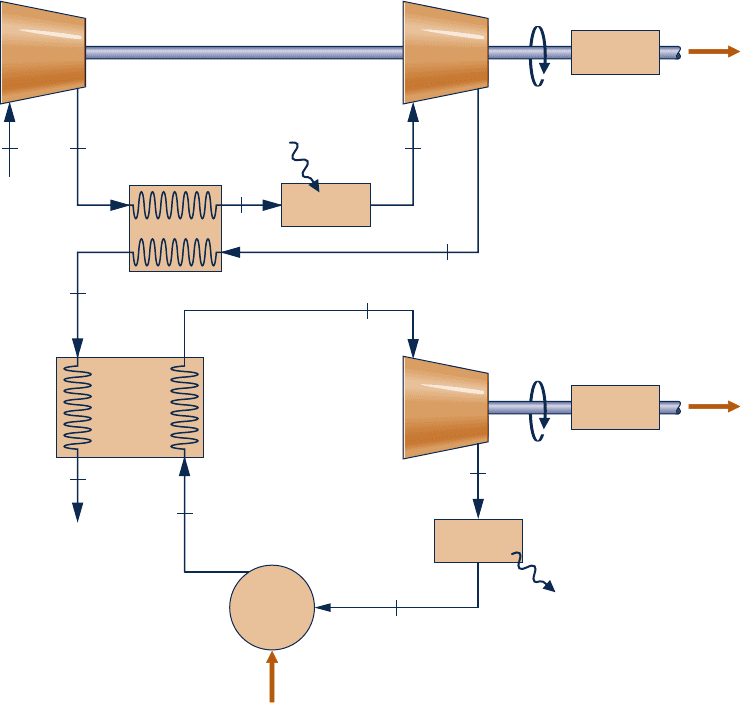
9.6D Owing to its very low temperature relative to seawater,
liquid natural gas (LNG) arriving at U.S. ports by ship has
considerable thermomechanical exergy. Yet when LNG is
regasified in heat exchangers where seawater is the other
stream, that exergy is largely destroyed. Conduct a search of
the patent literature for methods to recover a substantial
portion of LNG exergy during regasification. Consider
patents both granted and pending. Critically evaluate the
technical merit and economic feasibility of two different
methods found in your search. Report your conclusions in
an executive summary and PowerPoint presentation.
9.7D Develop the preliminary specifications for a 160-MW
closed-cycle gas turbine power plant. Consider carbon
dioxide and helium as possible gas turbine working fluids
that circulate through a nuclear power unit where they
absorb energy by heat transfer. Sketch the schematic of
your proposed cycle. For each of the two working fluids,
determine key operating pressures and temperatures of the
gas turbine cycle and estimate the expected performance
of the cycle. Write a report that includes your analysis and
design, and recommend a working fluid. Include at least
three references.
9.8D As an engineer you must recommend whether or not to
purchase 2 MW of electric power from the local utility
company at a cost of $0.06 per kW ? h for a plant expansion
or to purchase and operate a diesel engine generator set that
runs on natural gas. Assume natural gas is priced at 6 dollars
per thousand cubic feet, each cubic foot of gas has a heating
value
of 1000 Btu, and the plant operates 7800 h per year.
Specify diesel-generator equipment that would supply the
required power and perform an economic analysis to determine
which alternative is best. Present your recommendation in a
memorandum with supporting analysis and calculations,
including at least three references.
9.9D A financial services company has a computer server
facility that requires very reliable electric power. The power
demand is 3000 kW. The company has hired you as a
consultant to study the feasibility of using 250-kW
microturbines
for this application. Write a report discussing
the pros and cons of such an arrangement compared to
purchasing power from the local utility.
9.10D Figure P9.10D shows a combined cycle formed by a
topping gas turbine and an organic Rankine bottoming
cycle. Steady-state operating data are labeled on the figure.
Owing to internal irreversibilities, the generator electricity
output is 95% of the input shaft power. The regenerator
preheats air entering the combustor. In the evaporator, hot
exhaust gas from the regenerator vaporizes the bottoming
Design & Open-Ended Problems: Exploring Engineering Practice 585
Fig. P9.10D
1 2
6
7
9
11
3
5
8
10
Saturated liquid
4
Q
·
in
Compressor
Gas turbine cycle
Organic Rankine cycle
Turbine
W
·
GTC
Regenerator
Evaporator
W
·
e
= 100 kW
gen
= 95%
p
= 85%
reg
= 80%
c
= 85%
t
= 85%
T
1
= 300 K
p
1
= 100 kPa
T
4
= 1200 K
T
7
= T
8
+ 20 K
p
7
= p
1
p
9
p
8
, T
8
Combustor
Generator
Turbine
W
·
ORC
W
·
e
gen
= 95%
t
= 85%
Generator
Condenser
Q
·
out
W
p
˙
Pump
c09GasPowerSystems.indd Page 585 7/19/10 10:28:37 AM users-133 c09GasPowerSystems.indd Page 585 7/19/10 10:28:37 AM users-133 /Users/users-133/Desktop/Ramakant_04.05.09/WB00113_R1:JWCL170/New/Users/users-133/Desktop/Ramakant_04.05.09/WB00113_R1:JWCL170/New
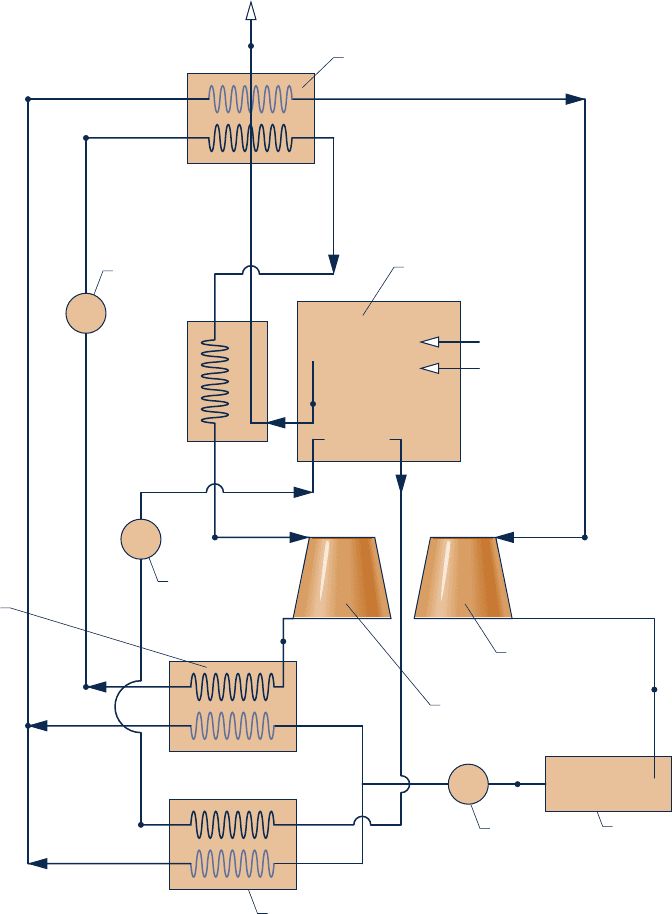
586 Chapter 9 Gas Power Systems
cycle working fluid. For each of three such working
fluids—propane, Refrigerant 22, and Refrigerant 134a—
specify appropriate ranges for p
8
, turbine inlet pressure,
and T
8
, turbine inlet temperature; also determine turbine
exit pressure p
9
. For each working fluid, investigate the
influence on net combined-cycle electricity production and
on combined-cycle thermal efficiency of varying p
8
, T
8
, and
compressor pressure ratio. Identify the bottoming working
fluid and operating conditions with greatest net combined-
cycle electricity production. Repeat for greatest combined-
cycle thermal efficiency. Apply engineering modeling
compatible with that used in the text for Rankine cycles
and air-standard analysis of gas turbines. Present your
analyses, results, and recommendations in a technical
article adhering to ASME standards with at least three
references.
9.11D Micro-CHP (combined heat and power) units capable of
producing up to 1.8 kW of electric power are now commercially
available for use in the home. Such units contribute to
domestic space or water heating needs while providing
electricity as a by-product. They operate on an internal
combustion engine fueled by natural gas. By hybridizing a
micro-CHP unit with a gas furnace, all
domestic heating needs
can be met while generating a substantial portion of the
annual electric power requirement. Evaluate this hybrid form
for application to a typical single-family dwelling in your
locale having natural gas service. Consider on-site battery
High-temperature
superheater
e
d
c
2
3
b
7
6
5
1
8
4
a
Engine exhaust
Low-temperature superheater,
High-temperature vapor generator
High-temperature
condenser,
Low-temperature
vapor generator
Radiator,
Low-temperature
condenser
Low-temperature
vapor generator
1-2-3-4-1:
5-6-7-8-5:
a-b-c:
d-e:
High-temperature cycle
Low-temperature cycle
Engine coolant
En
g
ine exhaust
g
as
Low-temperature
expander
High-temperature
expander
Pump
Pump
Four-cylinder
engine
Exhaust
gas
Coolant
Fuel
Air
Pump
Fig. P9.12D
c09GasPowerSystems.indd Page 586 7/19/10 10:28:39 AM users-133 c09GasPowerSystems.indd Page 586 7/19/10 10:28:39 AM users-133 /Users/users-133/Desktop/Ramakant_04.05.09/WB00113_R1:JWCL170/New/Users/users-133/Desktop/Ramakant_04.05.09/WB00113_R1:JWCL170/New
Design & Open-Ended Problems: Exploring Engineering Practice 587
storage of excess electricity generated and the possibility of net
metering. Specify equipment and determine costs, including
initial cost and installation cost. Estimate the annual cost for
heating and power using the hybrid and compare it to the
annual cost for heating and power with a stand-alone gas
furnace and grid power. Using your findings, recommend the
better approach for the dwelling.
9.12D Figure P9.12D provides the schematic of an internal
combustion automobile engine fitted with two Rankine
vapor power bottoming cycles: a high-temperature cycle
1-2-3-4-1 and a low-temperature cycle 5-6-7-8-5. These
cycles develop additional power using waste heat derived
from exhaust gas and engine coolant. Using operating
data for a commercially available car having a conventional
four-cylinder internal combustion engine with a size of 2.5
liters or less, specify cycle working fluids and state data
at key points sufficient to produce at least 15 hp more
power. Apply engineering modeling compatible with that
used in the text for Rankine cycles and air-standard
analysis of internal combustion engines. Write a final
report justifying your specifications together with
supporting calculations. Provide a critique of the use of
such bottoming cycles on car engines and a recommendation
about whether such technology should be actively pursued
by automakers.
c09GasPowerSystems.indd Page 587 7/19/10 10:28:41 AM users-133 c09GasPowerSystems.indd Page 587 7/19/10 10:28:41 AM users-133 /Users/users-133/Desktop/Ramakant_04.05.09/WB00113_R1:JWCL170/New/Users/users-133/Desktop/Ramakant_04.05.09/WB00113_R1:JWCL170/New

588
Refrigeration systems commonly used for preserving food are introduced in Sec. 10.1.
© Mike Kemp RubberBall/Age Fotostock America, Inc.
ENGINEERING CONTEXT Refrigeration systems for food preservation and air conditioning play
prominent roles in our everyday lives. Heat pumps also are used for heating buildings and for producing indus-
trial process heat. There are many other examples of commercial and industrial uses of refrigeration, including
air separation to obtain liquid oxygen and liquid nitrogen, liquefaction of natural gas, and production of ice.
To achieve refrigeration by most conventional means requires an electric power input. Heat pumps also
require power to operate. Referring again to Table 8.1, we see that in the United States electricity is obtained
today primarily from coal, natural gas, and nuclear, all of which are nonrenewable. These nonrenewables
have significant adverse effects on human health and the environment associated with their use. Depending
on the type of resource, such effects are related to extraction from the earth, processing and distribution,
emissions during power production, and waste products.
Ineffective refrigeration and heat pump systems, excessive building cooling and heating, and other wasteful
practices and lifestyle choices not only misuse increasingly scarce nonrenewable resources but also endanger
our health and burden the environment. Accordingly, refrigeration and heat pump systems is an area of appli-
cation where more effective systems and practices can significantly improve our national energy posture.
The objective of this chapter is to describe some of the common types of refrigeration and heat pump systems
presently in use and to illustrate how such systems can be modeled thermodynamically. The three principal
types described are the vapor-compression, absorption, and reversed Brayton cycles. As for the power sys-
tems studied in Chaps. 8 and 9, both vapor and gas systems are considered. In vapor systems, the refrigerant
is alternately vaporized and condensed. In gas refrigeration systems, the refrigerant remains a gas.
c10RefrigerationandHeatPumpSyste588 Page 588 7/23/10 6:18:44 PM user-s146c10RefrigerationandHeatPumpSyste588 Page 588 7/23/10 6:18:44 PM user-s146 /Users/user-s146/Desktop/Merry_X-Mas/New/Users/user-s146/Desktop/Merry_X-Mas/New

Refrigeration and
Heat Pump Systems
10
When you complete your study of this chapter, you will be able to...
c
Demonstrate understanding of basic vapor-compression refrigeration and heat pump
systems.
c
Develop and analyze thermodynamic models of vapor-compression systems and their
modifications, including
c
sketching schematic and accompanying T–s diagrams.
c
evaluating property data at principal states of the systems.
c
applying mass, energy, entropy, and exergy balances for the basic processes.
c
determining refrigeration and heat pump system performance, coefficient of performance
and capacity.
c
Explain the effects on vapor-compression system performance of varying key parameters.
c
Demonstrate understanding of the operating principles of absorption and gas refrigeration
systems, and perform thermodynamic analysis of gas systems.
LEARNING OUTCOMES
589
c10RefrigerationandHeatPumpSyste589 Page 589 6/21/10 3:28:10 PM user-s146c10RefrigerationandHeatPumpSyste589 Page 589 6/21/10 3:28:10 PM user-s146 /Users/user-s146/Desktop/Merry_X-Mas/New/Users/user-s146/Desktop/Merry_X-Mas/New
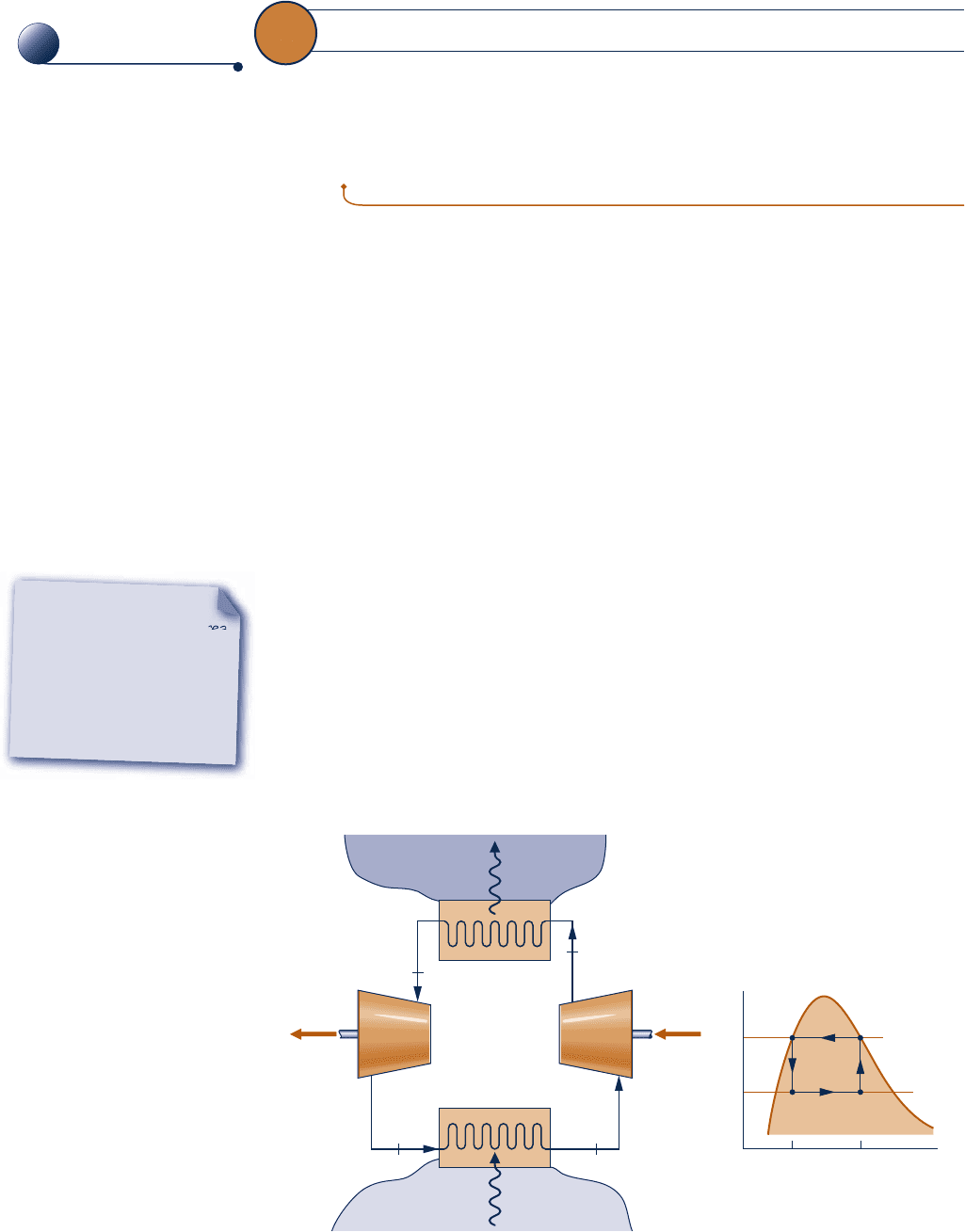
590 Chapter 10
Refrigeration and Heat Pump Systems
10.1 Vapor Refrigeration Systems
The purpose of a refrigeration system is to maintain a cold region at a temperature
below the temperature of its surroundings. This is commonly achieved using the vapor
refrigeration systems that are the subject of the present section.
10.1.1
Carnot Refrigeration Cycle
To introduce some important aspects of vapor refrigeration, let us begin by considering
a Carnot vapor refrigeration cycle. This cycle is obtained by reversing the Carnot vapor
power cycle introduced in Sec. 5.10. Figure 10.1 shows the schematic and accompanying
T–s diagram of a Carnot refrigeration cycle operating between a region at temperature
T
C
and another region at a higher temperature T
H
. The cycle is executed by a refriger-
ant circulating steadily through a series of components. All processes are internally
reversible. Also, since heat transfers between the refrigerant and each region occur with
no temperature differences, there are no external irreversibilities. The energy transfers
shown on the diagram are positive in the directions indicated by the arrows.
Let us follow the refrigerant as it passes steadily through each of the components in
the cycle, beginning at the inlet to the evaporator. The refrigerant enters the evaporator
as a two-phase liquid–vapor mixture at state 4. In the evaporator some of the refrigerant
changes phase from liquid to vapor as a result of heat transfer from the region at tem-
perature T
C
to the refrigerant. The temperature and pressure of the refrigerant remain
constant during the process from state 4 to state 1. The refrigerant is then compressed
adiabatically from state 1, where it is a two-phase liquid–vapor mixture, to state 2,
where it is a saturated vapor. During this process, the temperature of the refrigerant
increases from T
C
to T
H
, and the pressure also increases. The refrigerant passes from
the compressor into the condenser, where it changes phase from saturated vapor to
saturated liquid as a result of heat transfer to the region at temperature T
H
. The
temperature and pressure remain constant in the process from state 2 to state 3. The
refrigerant returns to the state at the inlet of the evaporator by expanding adiabati-
cally through a turbine. In this process, from state 3 to state 4, the temperature
decreases from T
H
to T
C
, and there is a decrease in pressure.
TAKE NOTE...
See Sec. 6.13.1 for the area
interpretation of heat trans-
fer on a T–s diagram for the
case of internally reversible
flow though a control volume
at steady state.
Fig. 10.1 Carnot vapor refrigeration cycle.
41
32
2
Condenser
Evaporator
Compressor
Q
out
·
Q
in
·
W
c
·
3
4 1
Turbine
Cold region at T
C
Warm region at T
H
W
t
·
T
s
ba
T
C
T
H
A
A
Refrig_Cycle
A.10 – All Tabs
c10RefrigerationandHeatPumpSyste590 Page 590 7/23/10 6:18:46 PM user-s146c10RefrigerationandHeatPumpSyste590 Page 590 7/23/10 6:18:46 PM user-s146 /Users/user-s146/Desktop/Merry_X-Mas/New/Users/user-s146/Desktop/Merry_X-Mas/New
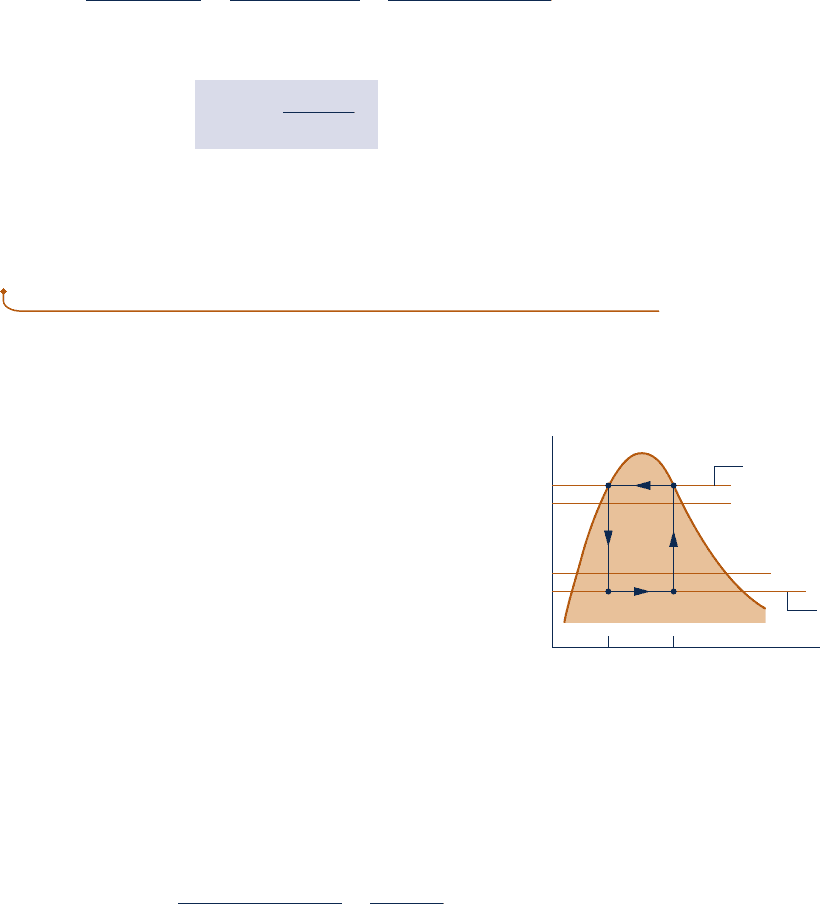
Since the Carnot vapor refrigeration cycle is made up of internally reversible pro-
cesses, areas on the T–s diagram can be interpreted as heat transfers. Area 1–a–b–4–1
is the heat added to the refrigerant from the cold region per unit mass of refrigerant
flowing. Area 2–a–b–3–2 is the heat rejected from the refrigerant to the warm region
per unit mass of refrigerant flowing. The enclosed area 1–2–3–4–1 is the net heat
transfer from the refrigerant. The net heat transfer from the refrigerant equals the net
work done on the refrigerant. The net work is the difference between the compressor
work input and the turbine work output.
The coefficient of performance b of any refrigeration cycle is the ratio of the refrig-
eration effect to the net work input required to achieve that effect. For the Carnot
vapor refrigeration cycle shown in Fig. 10.1, the coefficient of performance is
b
max
5
Q
#
in
/
m
#
W
#
c
/
m
#
2 W
#
t
/
m
#
5
area 1–a–b–4–
1
area 1–2–3–4–1
5
T
C
1s
a
2 s
b
2
1T
H
2 T
C
21s
a
2 s
b
2
which reduces to
b
max
5
T
C
T
H
2 T
C
(10.1)
This equation, which corresponds to Eq. 5.10, represents the maximum theoretical
coefficient of performance of any refrigeration cycle operating between regions at T
C
and T
H
.
10.1.2
Departures from the Carnot Cycle
Actual vapor refrigeration systems depart significantly from the Carnot cycle con-
sidered above and have coefficients of performance lower than would be calcu-
lated from Eq. 10.1. Three ways actual systems depart from the Carnot cycle are
considered next.
c One of the most significant departures is related to the heat trans-
fers between the refrigerant and the two regions. In actual systems,
these heat transfers are not accomplished reversibly as presumed
above. In particular, to achieve a rate of heat transfer sufficient to
maintain the temperature of the cold region at T
C
with a practi-
cal-sized evaporator requires the temperature of the refrigerant in
the evaporator, T9
C
, to be several degrees below T
C
. This is illus-
trated by the placement of the temperature T9
C
on the T–s diagram
of Fig. 10.2. Similarly, to obtain a sufficient heat transfer rate from
the refrigerant to the warm region requires that the refrigerant
temperature in the condenser, T9
H
, be several degrees above T
H
.
This is illustrated by the placement of the temperature T9
H
on the
T–s diagram of Fig. 10.2.
Maintaining the refrigerant temperatures in the heat exchangers at T9
C
and T9
H
rather than at T
C
and T
H
, respectively, has the effect of reducing the coefficient of
performance. This can be seen by expressing the coefficient of performance of the
refrigeration cycle designated by 19–29–39–49–19 on Fig. 10.2 as
b¿ 5
area 1¿–a–b–4¿–1
area 1¿–2¿–3¿–4¿–1¿
5
T
¿
C
T¿
H
2 T¿
C
(10.2)
Comparing the areas underlying the expressions for b
max
and b9 given above, we con-
clude that the value of b9 is less than b
max
. This conclusion about the effect of refriger-
ant temperature on the coefficient of performance also applies to other refrigeration
cycles considered in the chapter.
T
s
ba
Temperature of warm
region, T
H
Temperature of cold
region, T
C
Evaporator
temperature, T
C
Condenser
temperature, T
H
T
C
′
T
H
′
′
′
4′ 1′
3′ 2
′
Fig. 10.2 Comparison of the condenser and
evaporator temperatures with those of the warm
and cold regions.
10.1 Vapor Refrigeration Systems 591
c10RefrigerationandHeatPumpSyste591 Page 591 6/21/10 3:28:13 PM user-s146c10RefrigerationandHeatPumpSyste591 Page 591 6/21/10 3:28:13 PM user-s146 /Users/user-s146/Desktop/Merry_X-Mas/New/Users/user-s146/Desktop/Merry_X-Mas/New

592 Chapter 10
Refrigeration and Heat Pump Systems
c Even when the temperature differences between the refrigerant and
warm and cold regions are taken into consideration, there are other
features that make the vapor refrigeration cycle of Fig. 10.2 impractical
as a prototype. Referring again to the figure, note that the compres-
sion process from state 19 to state 29 occurs with the refrigerant as a
two-phase liquid–vapor mixture. This is commonly referred to as wet
compression. Wet compression is normally avoided because the pres-
ence of liquid droplets in the flowing liquid–vapor mixture can dam-
age the compressor. In actual systems, the compressor handles vapor
only. This is known as dry compression.
c Another feature that makes the cycle of Fig. 10.2 impractical is the expan-
sion process from the saturated liquid state 39 to the low-quality, two-
phase liquid–vapor mixture state 49. This expansion typically produces a
relatively small amount of work compared to the work input in the com-
pression process. The work developed by an actual turbine would be
smaller yet because turbines operating under these conditions have low
isentropic efficiencies. Accordingly, the work output of the turbine is nor-
mally sacrificed by substituting a simple throttling valve for the expansion
turbine, with consequent savings in initial and maintenance costs. The
10.2 Analyzing Vapor-Compression
Refrigeration Systems
Vapor-compression refrigeration systems are the most common refrigeration systems in
use today. The object of this section is to introduce some important features of sys-
tems of this type and to illustrate how they are modeled thermodynamically.
10.2.1
Evaluating Principal Work and Heat Transfers
Let us consider the steady-state operation of the vapor-compression system illustrated
in Fig. 10.3. Shown on the figure are the principal work and heat transfers, which are
positive in the directions of the arrows. Kinetic and potential energy changes are
neglected in the following analyses of the components. We begin with the evaporator,
where the desired refrigeration effect is achieved.
c As the refrigerant passes through the evaporator, heat transfer from the refrigerated
space results in the vaporization of the refrigerant. For a control volume enclosing
the refrigerant side of the evaporator, the mass and energy rate balances reduce to
give the rate of heat transfer per unit mass of refrigerant flowing as
Q
#
in
m
#
5 h
1
2 h
4
(10.3)
where m
#
is the mass flow rate of the refrigerant. The heat transfer rate
Q
#
in
is referred
to as the refrigeration capacity. In the SI unit system, the capacity is normally expressed
in kW. In the English unit system, the refrigeration capacity may be expressed in Btu/h.
Another commonly used unit for the refrigeration capacity is the ton of refrigeration,
which is equal to 200 Btu/min or about 211 kJ/min.
c The refrigerant leaving the evaporator is compressed to a relatively high pressure
and temperature by the compressor. Assuming no heat transfer to or from the
vapor-compression
refrigeration
refrigeration capacity
ton of refrigeration
4
1
32
Condenser
Evaporator
Compressor
Q
out
·
Q
in
·
W
c
·
Saturated or
superheated vapor
Expansion
valve
Fig. 10.3 Components of a vapor-
compression refrigeration system.
components of the resulting cycle are illustrated in Fig. 10.3, where dry compression is
presumed. This cycle, known as the vapor-compression refrigeration cycle, is the subject
of the section to follow.
c10RefrigerationandHeatPumpSyste592 Page 592 7/23/10 6:18:47 PM user-s146c10RefrigerationandHeatPumpSyste592 Page 592 7/23/10 6:18:47 PM user-s146 /Users/user-s146/Desktop/Merry_X-Mas/New/Users/user-s146/Desktop/Merry_X-Mas/New
